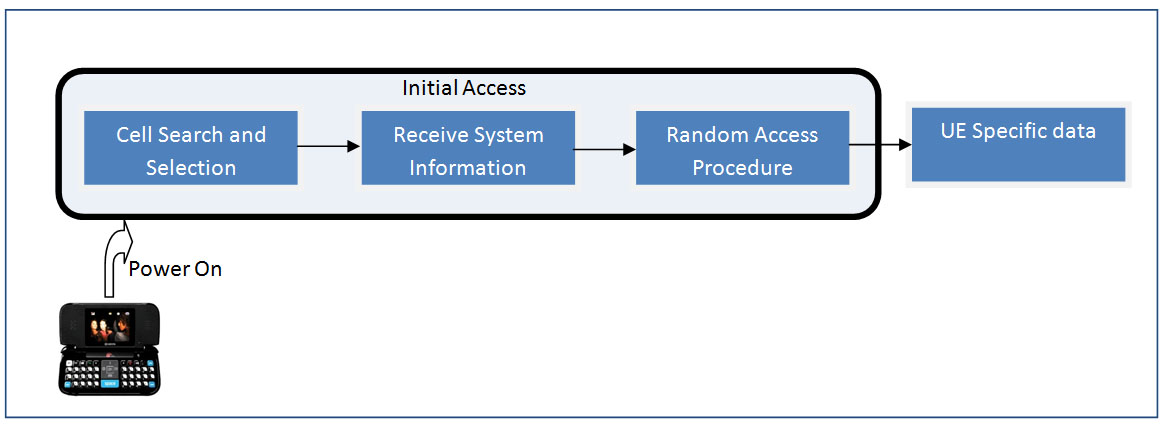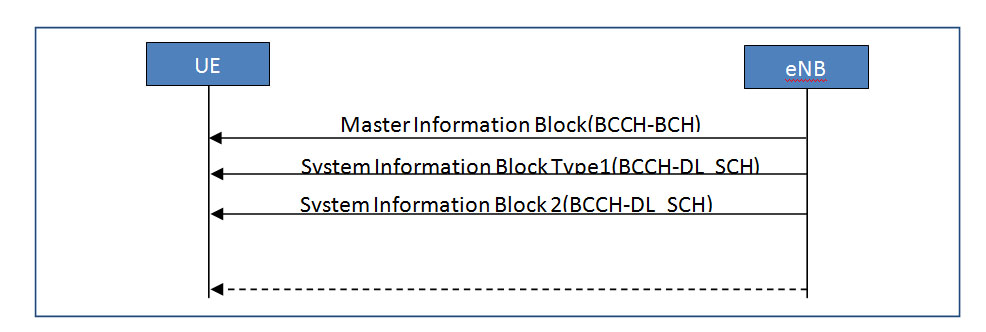UE Initial Access is the process between an UE is switched on and before sending UE specific signaling or data. The different steps for initial access are described below.
- Cell Search and Selection
- Receive System information
- Random access procedure
Cell Search and Selection
In order to know the cell search and selection first we have to know the physical signals and Physical channels in downlink for cell search and selection.
- Signals in downlink
- Primary and secondary Synchronization signal
- Cell Specific Down Link reference signal
- LTE Downlink Physical Channels
- Physical Broadcast Channel(PBCH): Provides essential system information(System Bandwidth)
LTE follows a hierarchical cell search, which means from primary and secondary synchronization signal it extracts the cell id and cell group id respectively. Then it combines both in a hierarchical manor to generate physical cell identity. For details about Physical hierarchy please follow the Note below
Note: Physical Cell id can be any no starting from 0-503. In order to manage this huge amount of cells, LTE has divided them in to 168 groups and in each group there can be 3 cells.
So Physical Cell ID = Cell Group ID * 3 + Cell ID
It may happen that UE is at the interference area of multiple cells; in that case UE may get multiple cell ids. In order to camp on a particular cell it has to decode cell specific reference signals.
Cell specific reference signal contains
- Downlink channel estimation for coherent demodulation.
- Channel Quality Indicator (CQI= QPSK/16 QAM/64 QAM depending on the signal strength).
Based on these parameters UE camps on a particular cell, and proceed to the next step “Receiving system information”
System Information Reception
After the cell selection now UE configures the BCCH-BCH channel and maps it on PBCH to receive Master Information Block (MIB).
Master Information Block (MIB)
- Dl bandwidth
- PHICH related information
After receiving MIB UE reconfigure the BCCH-DL-SCH channel and map it on PDSCH to receive System Information Block Type1 (SIB1).
System Information Block Type1 (SIB1)
- PLMN Information
- TAC
- Physical Cell ID and specific info
- Scheduling information of other System Information Blocks(SIB2, SIB3, SIB4….)
After receiving the SIB1 UE gets the scheduling information about other SIBs (In which sub-frame, the subsequent SIBs can be received). But the most important SIB block for basic call in LTE is SIB2. So UE reconfigures the BCCH-DL-SCH to receive the SIB2.
System Information Block 2(SIB2)
- Common Channel Information
- Random Access Channel Information
- Random Access Preamble Info
- HARQ info
Till now all the things that are happening is on down link. After Sib2 reception UE configures the Random Access Channel and Common shared channel and starts uplink synchronization using Random Access Procedure.
Random Access Procedure:
In LTE all the UE uses the same shared resources to get the initial access. So Random Access Procedure is always contention based. In this procedure UE get the initial UL grant to transmit UE specific UL packets for first time.
Random Access Preamble:
This is generated by MAC layer in uplink on RACH-PRACH. There are two possible groups defined group A and B from which one is optional. If both groups are configured, the size of message 3 and the path loss are used to determine preamble group. The group to which a preamble belongs provides an indication of the size of the message 3(RRC Connection req) and the radio conditions at the UE. The preamble group information and thresholds are already been received in system information block 2.
Random Access Response:
This is generated by MAC in downlink on DL-SCH-PDSCH. After sending the Random Access Preamble UE watches the RA-RNTI in PDCCH. From that it gets the information about the Random Access Response (in which sub frame it is arriving in PDSCH). This response carries the temporary C-RNTI assigned by the eNB and UL grant. C-RNTI is used for transmission and reception of UE specific UL and DL data.
Note: UL and DL transmission and scheduling can be discussed in some other post.
RRC Connection Request :
This is generated by RRC layer on CCCH-UL_SCH. This is called as message3 and first UE specific signalling from L3(RRC). This carries the UE specific identity. The UE identity can me Random or S-TMSI (if UE is already registered to the EPC and S-TMSI is with UE). It also carries the establishment cause.
MAC Contention Resolution:
This is generated by MAC on DL-SCH. It may happen that simultaneously more than one RRC connection request is received at eNB on same shared channel. So in order to separate out the UEs eNB uses the contention resolution much prior to the NAS based contention. Here LTE uses the timer based contention resolution. After receiving the message3 eNB schedules that request and send the information to the UE through MAC contention resolution message.
LTE References
For LTE check out LTE for UMTS: Evolution to LTE-Advanced and LTE Signaling: Troubleshooting and Optimization
Do you have some questions? Use the comment section below.





Permalink
very nice same some detail found at below,..
teletopix.blogspot.com
Permalink
Who will configure the group number for RACH ?? On what basis ?? Any reference??
Permalink
Hi, I have a question as below.
When eNB has allocated UL grant in random access response why would there be contention when eNB processes RRC request .? For what transmission the eNB allocated the UL grant.
Thanks,
Naresh N
Permalink
When ue has powered on then it will go directly for raching or send scheduling request msg